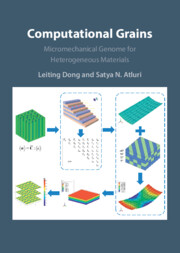Book contents
- Computational Grains
- Computational Grains
- Copyright page
- Contents
- Preface
- 1 Introduction
- 2 Computational Homogenization in the Micromechanics of Heterogeneous Materials
- 3 Direct Numerical Simulation of Materials Using Computational Grains
- 4 Trefftz Trial Functions for Computational Grains for Planar and 3D Problems
- 5 Computational Grains for Particulate Composites and Porous Materials
- 6 Computational Grains for Cylindrical Fiber Composites
- 7 Computational Grains for Nanocomposites
- 8 Computational Grains for Composites with Coated Inclusions
- 9 Computational Grains for Viscoelastic Composites
- 10 Computational Grains for Piezoelectric Composites/Porous Materials
- 11 Computational Grains with Embedded Microcracks in the Matrix and Inclusions
- 12 Multi-Scale Modeling of Composite Structures Using Computational Grains
- Index
- References
6 - Computational Grains for Cylindrical Fiber Composites
Published online by Cambridge University Press: 05 October 2023
- Computational Grains
- Computational Grains
- Copyright page
- Contents
- Preface
- 1 Introduction
- 2 Computational Homogenization in the Micromechanics of Heterogeneous Materials
- 3 Direct Numerical Simulation of Materials Using Computational Grains
- 4 Trefftz Trial Functions for Computational Grains for Planar and 3D Problems
- 5 Computational Grains for Particulate Composites and Porous Materials
- 6 Computational Grains for Cylindrical Fiber Composites
- 7 Computational Grains for Nanocomposites
- 8 Computational Grains for Composites with Coated Inclusions
- 9 Computational Grains for Viscoelastic Composites
- 10 Computational Grains for Piezoelectric Composites/Porous Materials
- 11 Computational Grains with Embedded Microcracks in the Matrix and Inclusions
- 12 Multi-Scale Modeling of Composite Structures Using Computational Grains
- Index
- References
Summary
In this chapter, a new kind of Computational Grain (CG) with embedded cylindrical elastic fibers is developed for the micromechanical modeling of fiber-reinforced composites. The trial displacement fields within the CGs are assumed using Papkovich-Neuber solutions. Cylindrical harmonics scaled by characteristic lengths are employed as the P-N potentials. A compatible displacement field is assumed at elemental surfaces and fiber–matrix interfaces, and the stiffness matrices of CGs are derived by a newly developed multi-field boundary variational principle.
Through numerical simulations, we demonstrate that the developed CGs have high computational efficiency, and they can accurately capture the localized stress distributions under various loadings. Computational Grains are also effective for estimating the effective material properties of fiber-reinforced composites, as validated by comparing with experimental results in the literature. Moreover, with the use of parallel computation, the time required for CGs is significantly decreased. Thus, we consider that the kind of CGs developed in this study is an accurate and efficient tool for the micromechanical modeling of fiber composites. Such a tool of micromechanical modeling can also be combined with meso- and macro-scale finite elements for the multi-scale analysis of laminates and composite parts, which will be given in Chapter 12.
Keywords
Information
- Type
- Chapter
- Information
- Computational GrainsMicromechanical Genome for Heterogeneous Materials, pp. 110 - 126Publisher: Cambridge University PressPrint publication year: 2023
